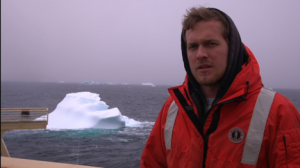23 year old Pete (pictured above) is about two years into his Antarctic sailing experience. As first-mate on the Laurence M. Gould, he challenges himself through the iceberg-ridden and uncharted seas to get our team of scientists safely to Palmer Station and around the West Peninsula. The journey they take to get there is not an easy or short one, but with Pete’s expertise, it is completely possible.
The science cruise starts when the ship leaves Punta Arenas in Chile, and heads South. Eventually, the ship enters the Drake Passage, into the Boyd Strait, and across the Brans Field. This travel is so far ice-less until the vessel gets to the Croker Passage, where the real Antarctic experience begins. “That’s the first area where navigation gets a little tight, in terms of how close the vessel is to the shoreline,” Pete tells us in an interview. Heading Southwest, the Laurence M. Gould heads into the Gerlache Strait, where penguins and other wildlife are noticed. From the Gerlache Strait, the vessel enters the Neumayer Channel, where there are much heavier ice conditions. The Neumayer is only about a half mile to a mile wide from shoreline to shoreline, which makes the ice pack full and tight. Once out of the Neumayer, our team is headed into the Bismark Strait. Finally, from there, they make their way into Palmer Station.
There are many dangers in this long journey where navigation is key to safety. Pete lets us know that his most important job is keeping the vessel and science gear as far away from ice as possible. Although not all ice is as extreme as it sounds, many types are a great risk to the vessel and the science going on. With the help of all the equipment that is in the bridge (where Pete works), navigating around ice becomes a little easier, but still just as dangerous. However, for Pete, dodging icebergs is “kind of exhilarating”.




 Follow the
Follow the  Subscribe to the blog RSS feed
Subscribe to the blog RSS feed